Open-Source Implementations of the Reactive Asset Administration Shell: A Survey
Abstract
1. Introduction
2. Open-Source Implementations
2.1. Methodology and Selection
- dfkibasys/asset-administration-shell: because it is an extension with very limited features based on the well-established Eclipse BaSyx implementation already present in the list, and
- JMayrbaeurl/opendigitaltwins-aas-azureservices: as the documentation is inadequate and this software therefore could not be started and tested by us.
2.2. Selected Implementations
2.2.1. AASX Server
- core containing only the server with a command-line interface (CLI) using .NET Core,
- blazor also containing a graphical user interface (GUI), and
- windows for running on windows without administrator privileges using .NET Framework.
2.2.2. Eclipse BaSyx
2.2.3. FA3ST Service
2.2.4. NOVAAS
3. Evaluation Approach
3.1. Evaluation Criteria
3.1.1. General Criteria
- Main Contributors: Which organizations are the main contributors driving the implementation? We consider an organization a main contributor if it provided at least five commits and ten thousand lines of code.
- License: Under which license is the implementation published? The license affects which rights and obligations a user has and whether it is compatible with its own development guidelines.
- Programming Language: Which programming language(s) does the implementation use?
- Usage: What types of usage does the implementation support? Three typical types of usage are considered: via a command-line interface (CLI), as a docker container, or as an embedded library from custom code.
3.1.2. AAS-Specific Criteria
- Metamodel Version: Which version of the AAS metamodel (as defined in the AAS specification Part 1) is supported by the implementation? Since 2018, at least three versions of the specification have been published [2].
- Model Formats: According to AAS specification Part 1, the AAS metamodel can be serialized using multiple different serialization formats. This criterion describes which of these serialization formats is supported by an implementation. Support for different serialization formats is relevant for two aspects: importing an existing AAS model upon start-up as well as for communication via HTTP although the AAS specification defines JSON as the only supported serialization format for communication via HTTP. This criterion therefore primarily focuses on the supported serialization formats for the import of existing AAS models at start-up. As the serialization formats AutomationML (AML) and OPC UA NodeSet are not developed by the authors of the AAS specification but rather standardization bodies related to AML resp. OPC UA, standardization of these serialization formats is not published as part of the AAS specification itself. Therefore, we only consider AASX, JSON, XML, and RDF in this paper.
- API Interfaces: The AAS specification Part 2 defines as set of so-called Interfaces consisting of Operations describing the AAS API in a protocol-agnostic manner. This criterion describes to which degree these interfaces and operations are supported by an implementation. The interfaces AAS Registry and Submodel Registry are excluded from this list as they are typically implemented as separate applications. They are therefore later introduced as the ecosystem criteria Registry. For some of these interfaces, we evaluate these criteria based on actual tests described later in this section. The rest is evaluated based on documentation.
- API Protocols: Which protocols can be used to communicate with the AAS via its API? So far, there are proposals on how to map the protocol-agnostic interfaces and operations to HTTP and OPC UA, although no official final version of these mappings has been released.
3.1.3. Implementation-Specific Criteria
- Asset Synchronization: Synchronizing the (physical) asset(s) with their digital representation, the AAS, is an essential requirement when working with DTs. However, this aspect is not covered by the AAS specification at all. We introduce this criterion, as from our perspective this is an essential capability of a DT. This criterion includes asset connectivity regarding three well-established communication protocols, HTTP, MQTT, and OPC UA, combined with the four interaction patterns for DTs, read, write, execute, and subscribe.
- Data Persistence: An AAS Type 2 implementation allows modifying the hosted AAS model at run-time which raises the question of how these data can persist by the implementation. This criterion describes three possible forms of persistence: in-memory (meaning all changes are lost if the software is stopped), file-based (meaning the AAS model is serialized to a file according to one of the supported serialization formats), and database-based (meaning the data persist in a database). Often implementations support multiple of these types of persistence and allow switching between them with little effort.
- Security: Similar to asset synchronization, security is not (properly) addressed in the AAS specification. Nevertheless, as it is an essential aspect when using any implementation in real-world applications, we introduce this as a separate criterion. Possible implementations may greatly differ in complexity and the level of security they provide, especially when it comes to access control. In this paper, the primary aspect is if the implementations offer any solution to security at all and not the level of maturity.
- Other Features: This criterion shall be used to present additional features of an implementation that seem relevant and do not fall into the above categories.
3.1.4. Ecosystem Criteria
- Client Library: Connecting applications to deployed Type 2 AAS is essential. This requires applications to know and “speak” the AAS APIs. A client library offers an easy-to-use software library that hides the complexity of the AAS API and therefore simplifies and accelerates the development of applications using the DT. However, it typically needs multiple client libraries targeting different programming languages.
- Model Editor: Modeling a DT can be a complex task and is often not done by software developers familiar with the different serialization formats of the AAS. A model editor simplifies that task by offering a graphical user interface to easily create and modify the AAS model also for non-experts.
- Model Validation: Does the implementation or framework verify the compliance of a given AAS model with the specification including all constraints defined? This primarily focuses on a separate explicit validation step or tool that is executed automatically or manually and provides clear indicators of how the model violates the constraints. It is noticed that every implementation inherently has some sort of implicit validation in the form of crashing or throwing an exception when called with an invalid model. However, these implicit validations do typically not provide detailed and helpful information on the cause and leave a user puzzled about how to fix the model. Therefore, this criterion is only fulfilled if an implementation provides at least some form of explicit validation.
- Registry: Although the interfaces AAS Registry and Submodel Registry are defined in the AAS specification Part 2 together with all the other interfaces, they are not considered part of an AAS Type 2 but rather a tool on its own.
- Visualization: By visualization, we refer to some sort of graphical user interface visually depicting the current state of the AAS. Visualizations can come in many forms, e.g., depicting the AAS model structure or displaying a single value over time as a graph. Visualizations are sometimes combined with a model editor allowing the modification of the AAS model at run-time.
- Other: What other relevant, interesting, and/or unique tools are part of the ecosystem?
3.2. Test Framework
3.2.1. AAS Model
3.2.2. Test Cases
API Interfaces
Asset Synchronization
4. Evaluation Results
4.1. Detailed Results
4.1.1. AASX Server
4.1.2. Eclipse BaSyx
4.1.3. FA3ST Service
4.1.4. NOVAAS
4.2. Discussion
5. Related Work
6. Conclusions
Author Contributions
Funding
Data Availability Statement
Acknowledgments
Conflicts of Interest
Abbreviations
| AAS | Asset Administration Shell |
| AASX | Asset Administration Shell Exchange Format |
| AML | Automation Markup Language |
| API | Application Programming Interface |
| ARel | Annotated Relationship Element |
| Blob | Binary large object |
| BMBF | German Federal Ministry of Education and Research |
| CLI | Command-Line Interface |
| CD | Concept Description |
| DT | Digital Twin |
| DTC | Digital Twin Consortium |
| EDC | Eclipse Dataspace Connector |
| EU | European Union |
| e.V. | incorporated association, in German: eingetragener Verein |
| FA3ST | Fraunhofer Advanced Asset Administration Shell Tools for Digital Twins |
| GUI | Graphical User Interface |
| HTTP | Hypertext Transfer Protocol |
| I4.0 | Industry 4.0 |
| IDTA | Industrial Digital Twin Association |
| IETF | Internet Engineering Task Force |
| IOSB | Fraunhofer Institute of Optronics, System Technologies and Image Exploitation |
| JSON | JavaScript Object Notation |
| MLP | Multi Language Property |
| MQTT | Message Queuing Telemetry Transport |
| NOVAAS | NOVA Asset Administration Shell |
| OASIS | Organization for the Advancement of Structured Information Standards |
| OPC UA | Open Platform Communications Unified Architecture |
| RDF | Resource Description Format |
| Ref | Reference Element |
| Rel | Relationship Element |
| REST | Representational State Transfer |
| SDK | Software Development Kit |
| SM | Submodel |
| SMC | Submodel Element Collection |
| SMT | Submodel Template |
| UI | User Interface |
| URL | Uniform Resource Locator |
| XLS | Microsoft Excel Spreadsheet |
| XML | Extensible Markup Language |
References
- Martikkala, A.; David, J.; Lobov, A.; Lanz, M.; Ituarte, I.F. Trends for Low-Cost and Open-Source IoT Solutions Development for Industry 4.0. Procedia Manuf. 2021, 55, 298–305. [Google Scholar] [CrossRef]
- Asset Administration Shell Specifications. Available online: https://www.plattform-i40.de/IP/Redaktion/EN/Standardartikel/specification-administrationshell.html (accessed on 12 April 2023).
- Plattform Industrie 4.0. Available online: https://www.plattform-i40.de/IP/Navigation/EN/Home/home.html (accessed on 12 April 2023).
- Jacoby, M.; Volz, F.; Weißenbacher, C.; Müller, J. FA³ST Service–An Open Source Implementation of the Reactive Asset Administration Shell. In Proceedings of the 2022 IEEE 27th International Conference on Emerging Technologies and Factory Automation (ETFA), Stuttgart, Germany, 6–9 September 2022; pp. 1–8. [Google Scholar]
- European Commission. Open Source Software Strategy 2020–2023—Think Open. 2020. Available online: https://ec.europa.eu/info/sites/default/files/en_ec_open_source_strategy_2020-2023.pdf (accessed on 12 April 2023).
- Schlemmer, A. Open Source: How the Sector Has Changed. Available online: https://www.forbes.com/sites/forbesbusinesscouncil/2022/03/11/open-source-how-the-sector-has-changed (accessed on 12 April 2023).
- Bitkome, V. Open Source Monitor—Survey Report 2021. Available online: https://www.bitkom.org/sites/main/files/2022-04/220405_Bitkom_Studie_OpenMonitor_2021_ENG.pdf (accessed on 12 April 2023).
- Barnstedt, E.; Boss, B.; Clauer, E.; Isaacs, D.; Lin, S.W.; Malakuti, S.; van Schalkwykm, P.; Weber Martins, T. Open Source Drives Digital Twin Adoption. Available online: https://www.iiconsortium.org/pdf/2021_March_JoI_Open_Source_Drives_Digital_Twin_SA.pdf (accessed on 12 April 2023).
- Ward, D. Open Standards, Open Source, Open Loop. Available online: https://www.ietfjournal.org/open-standards-open-source-open-loop (accessed on 12 April 2023).
- Organization for the Advancement of Structured Information Standards (OASIS). Available online: https://www.oasis-open.org/ (accessed on 12 April 2023).
- Eclipse Foundation. How is the Eclipse Foundation Specification Process (EFSP) Different from the Java Community Process (JCP)? Available online: https://www.eclipse.org/community/eclipse_newsletter/2019/january/EFSP_vs_JCP.php (accessed on 12 April 2023).
- The Linux Foundation. The Joint Development Foundation Joins the Linux Foundation Family to Drive Adoption of Open Source and Standards. Available online: https://www.linuxfoundation.org/press-release/jdf-joins-lf-family (accessed on 12 April 2023).
- Industrial Digital Twin Association. Available online: https://industrialdigitaltwin.org (accessed on 12 April 2023).
- Digital Twin Consortium. Available online: https://www.digitaltwinconsortium.org (accessed on 12 April 2023).
- Details of the Asset Administration Shell—Part 1 Version 3.0RC02. Available online: https://www.plattform-i40.de/IP/Redaktion/EN/Downloads/Publikation/Details_of_the_Asset_Administration_Shell_Part1_V3.html (accessed on 12 April 2023).
- Details of the Asset Administration Shell—Part 2 Version 1.0RC02. Available online: https://www.plattform-i40.de/IP/Redaktion/EN/Downloads/Publikation/Details_of_the_Asset_Administration_Shell_Part2_V1.html (accessed on 12 April 2023).
- Github Open-Source—Where Open Source Communicties Live. Available online: https://github.com/open-source (accessed on 12 April 2023).
- Gusenbauer, M. Google Scholar to overshadow them all? Comparing the sizes of 12 academic search engines and bibliographic databases. Scientometrics 2019, 118, 177–214. [Google Scholar] [CrossRef]
- AASX Server Respository. Available online: https://github.com/admin-shell-io/aasx-server (accessed on 12 April 2023).
- AASX Package Explorer Respository. Available online: https://github.com/admin-shell-io/aasx-package-explorer (accessed on 12 April 2023).
- Eclipse BaSyx Respository. Available online: https://github.com/eclipse-basyx (accessed on 12 April 2023).
- Eclipse BaSyx. Available online: https://projects.eclipse.org/projects/dt.basyx (accessed on 12 April 2023).
- Eclipse BaSys 4.2. Available online: https://www.iese.fraunhofer.de/en/customers_industries/digitalisierung-produktion/industrie40/basys42.html (accessed on 12 April 2023).
- FA³ST Service Respository. Available online: https://github.com/FraunhoferIOSB/FAAAST-Service (accessed on 12 April 2023).
- NovAAS Respository. Available online: https://gitlab.com/novaas/catalog/nova-school-of-science-and-technology/novaas (accessed on 12 April 2023).
- di Orio, G.; Maló, P.; Barata, J. NOVAAS: A Reference Implementation of Industrie4.0 Asset Administration Shell with best-of-breed practices from IT engineering. In Proceedings of the IECON 2019—45th Annual Conference of the IEEE Industrial Electronics Society, Lisbon, Portugal, 14–17 October 2019; Volume 1, pp. 5505–5512. [Google Scholar]
- PROPHECY EU Project. Available online: https://prophesy.eu/ (accessed on 12 April 2023).
- Stojanovic, L.; Usländer, T.; Volz, F.; Weißenbacher, C.; Müller, J.; Jacoby, M.; Bischoff, T. Methodology and Tools for Digital Twin Management—The FA³ST Approach. IoT 2021, 2, 717–740. [Google Scholar] [CrossRef]
- Industrial Digital Twin Association. Registered AAS Submodel Templates. Available online: https://industrialdigitaltwin.org/content-hub/teilmodelle (accessed on 12 April 2023).
- FA³ST Package Explorer Converter Respository. Available online: https://github.com/FraunhoferIOSB/FAAAST-Package-Explorer-Converter (accessed on 12 April 2023).
- AAS HTTP API—Entire Interface Collection v1.0RC01. Available online: https://app.swaggerhub.com/apis/Plattform_i40/Entire-Interface-Collection/V1.0RC01 (accessed on 12 April 2023).
- AASX Server Source Code—AasxRestServer.cs. Available online: https://github.com/admin-shell-io/aasx-server/blob/744069e8b49ab75baf1e21d6f65128dcdcc22115/src/AasxServerStandardBib/AasxRestServer.cs#L29 (accessed on 12 April 2023).
- AASX Client Respository. Available online: https://github.com/admin-shell-io/aasx-client (accessed on 12 April 2023).
- AASX Registry Respository. Available online: https://github.com/admin-shell-io/aasx-registry (accessed on 12 April 2023).
- AASX XLS Respository. Available online: https://github.com/admin-shell-io/aasx-xls-parser (accessed on 12 April 2023).
- AASX Server Release 2022-07-27.alpha. Available online: https://github.com/admin-shell-io/aasx-server/releases/tag/v2022-07-25.alpha (accessed on 12 April 2023).
- Eclipse BaSyx Java SDK v2. Available online: https://github.com/eclipse-basyx/basyx-java-sdk/tree/development-v2 (accessed on 12 April 2023).
- Eclipse BaSyx Java Components v2. Available online: https://github.com/eclipse-basyx/basyx-java-components/tree/development-v2 (accessed on 12 April 2023).
- Eclipse BaSyx Java SDK v1.3.0. Available online: https://github.com/eclipse-basyx/basyx-java-sdk/releases/tag/1.3.0 (accessed on 12 April 2023).
- Eclipse BaSyx Java Components v1.3.0. Available online: https://github.com/eclipse-basyx/basyx-java-components/releases/tag/1.3.0 (accessed on 12 April 2023).
- EDC Extension for AAS Respository. Available online: https://github.com/FraunhoferIOSB/EDC-Extension-for-AAS (accessed on 12 April 2023).
- NovAAS Hydraulic Unit Simulation. Available online: https://gitlab.com/novaas/catalog/nova-school-of-science-and-technology/novaas-hydraulic-unit-simulation (accessed on 12 April 2023).
- NovAAS OPC UA Simulation Server. Available online: https://gitlab.com/novaas/catalog/nova-school-of-science-and-technology/novaas-prosys-opc-ua-simulation-server (accessed on 12 April 2023).
- NovAAS Keycloak Repository. Available online: https://gitlab.com/novaas/catalog/nova-school-of-science-and-technology/novaas-keycloak (accessed on 12 April 2023).
- Evans, B.; Braun, S.; Ulmer, J.; Wollert, J. AAS implementations—Current Problems and Solutions. In Proceedings of the 2022 20th International Conference on Mechatronics-Mechatronika (ME), Pilsen, Czech Republic, 7–9 December 2022; pp. 1–6. [Google Scholar]
- Yallıç, F.; Albayrak, Ö.; Ünal, P. Asset Administration Shell Generation and Usage for Digital Twins: A Case Study for Non-destructive Testing. In Proceedings of the 3rd International Conference on Innovative Intelligent Industrial Production and Logistics-ETCIIM, INSTICC, Valletta, Malta, 24–26 October 2022; SciTePress: Setubal, Portugal, 2023; pp. 299–306. [Google Scholar]
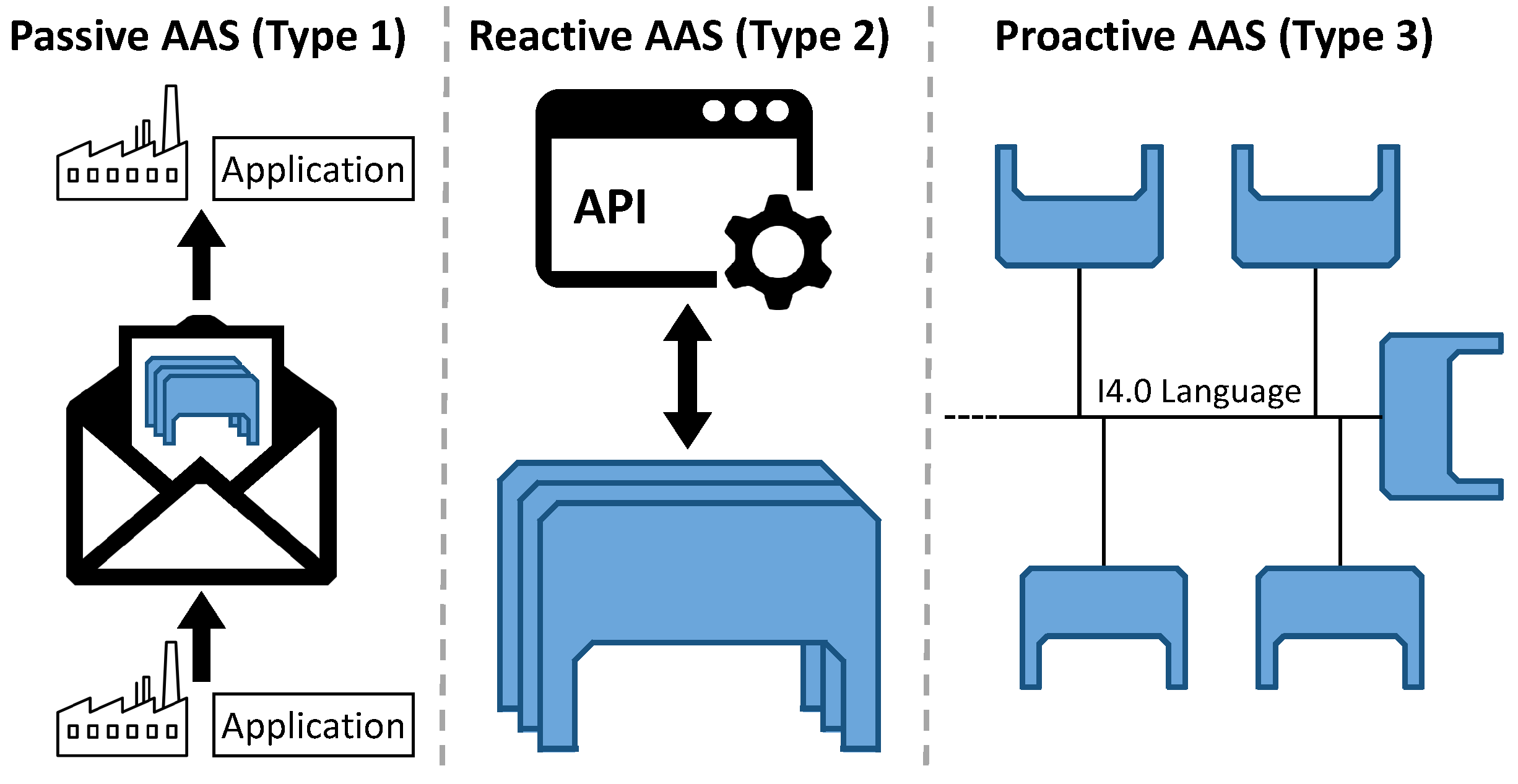
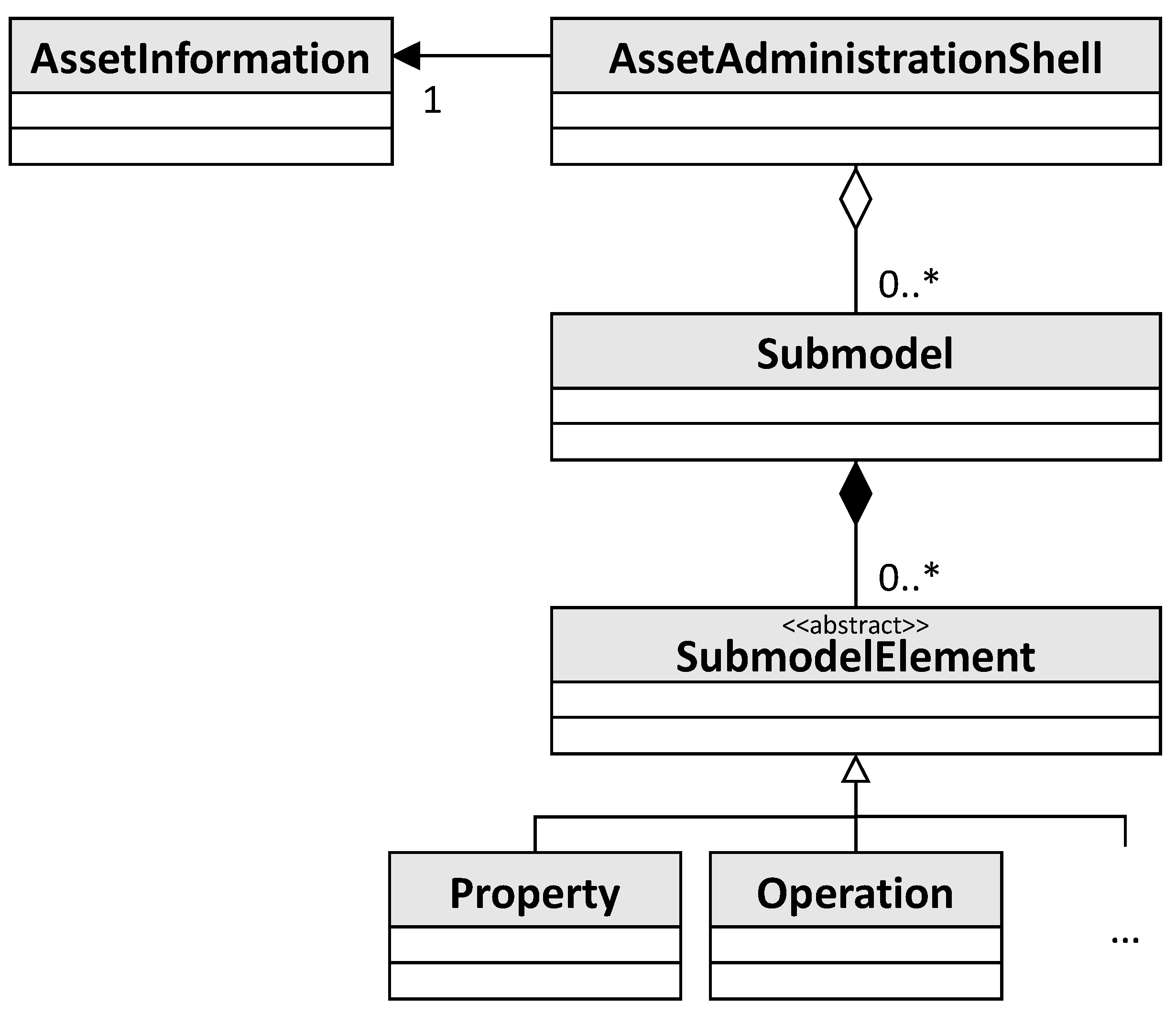
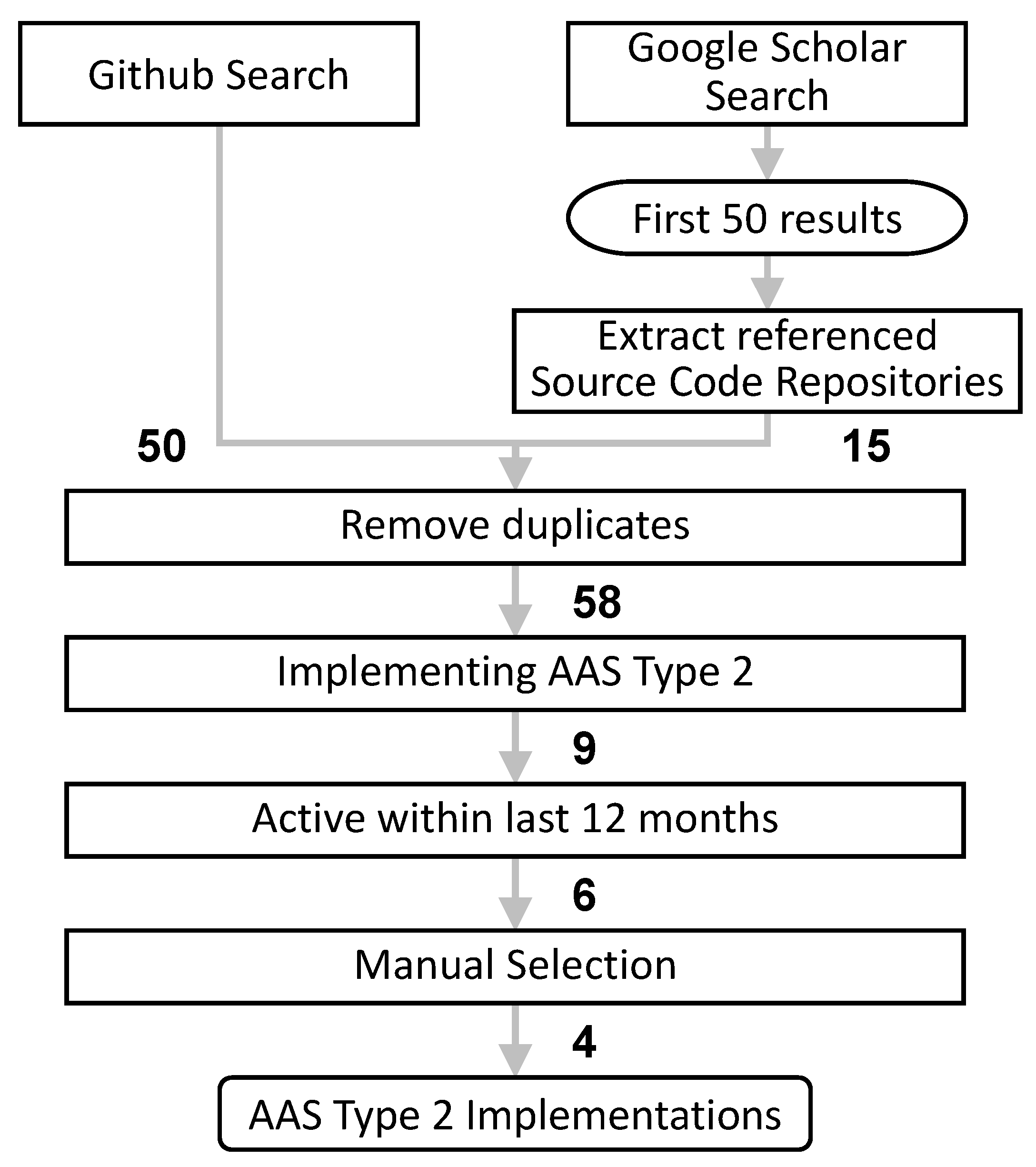
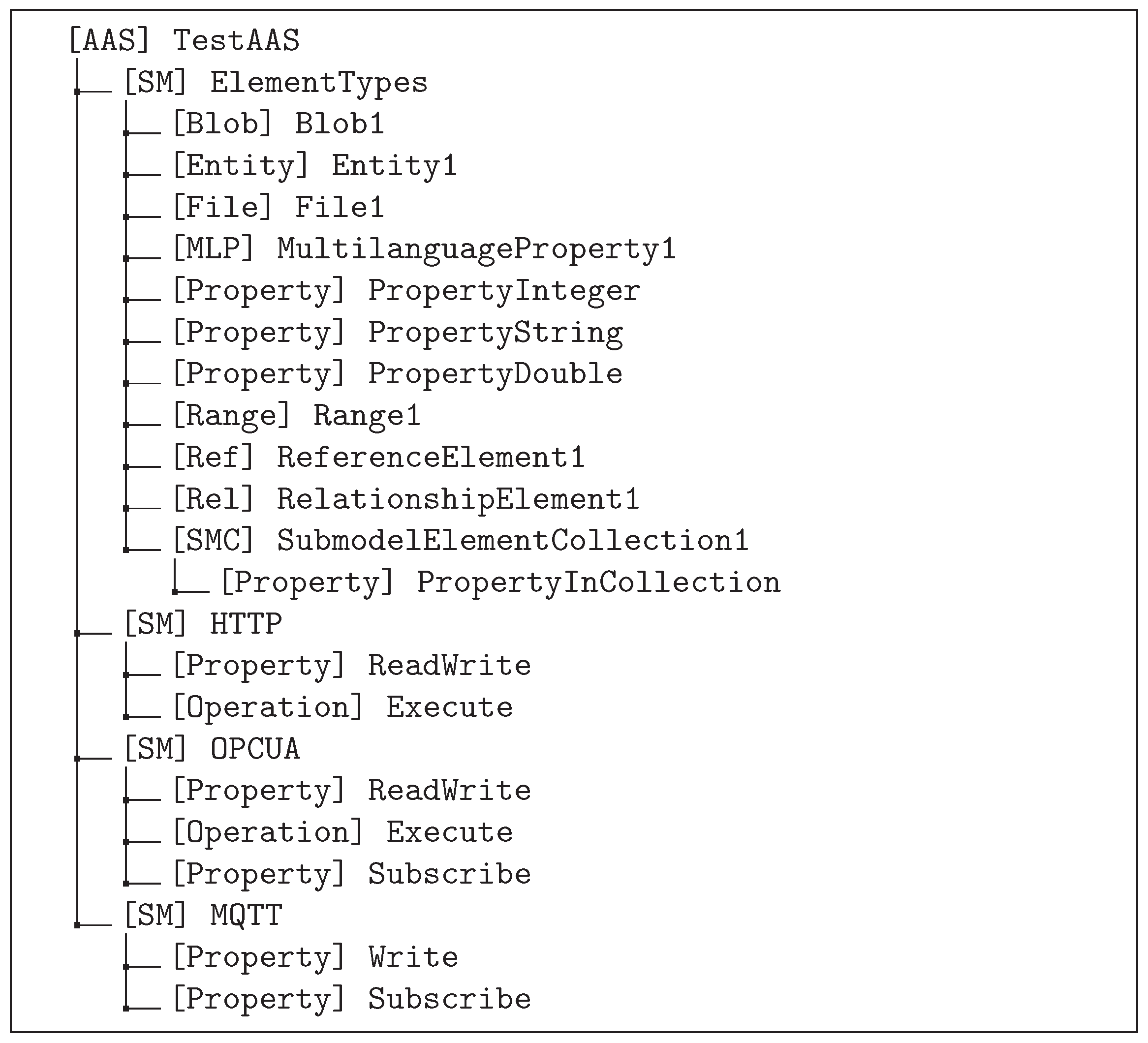
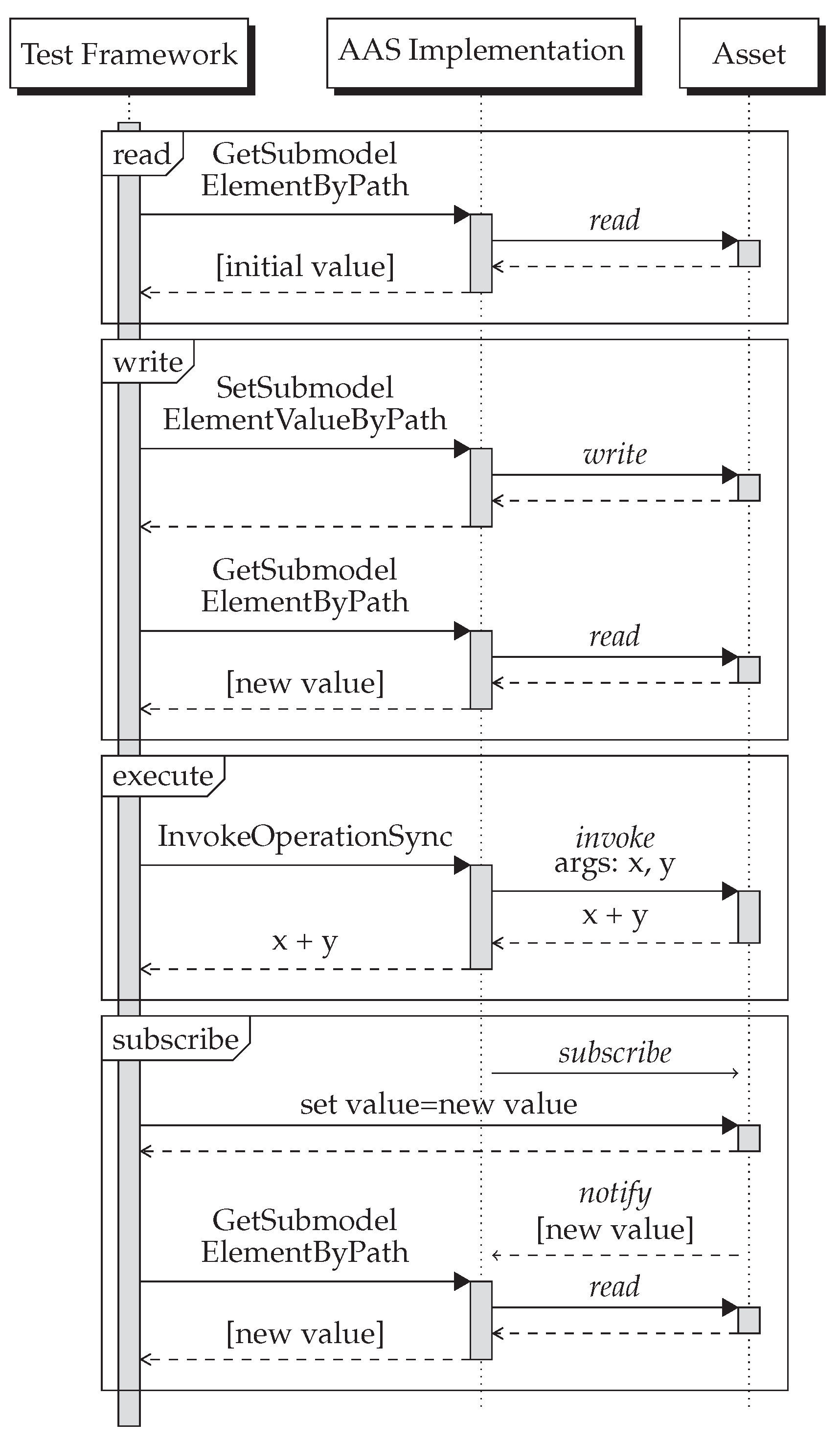
| IDTA Number | Short Name | ARel | Blob | Capability | Entity | File | MLP | Operation | Property | Range | Ref | Rel | SMC |
|---|---|---|---|---|---|---|---|---|---|---|---|---|---|
| 02001-1-0 | Module Type Package | ✓ | ✓ | ✓ | ✓ | ||||||||
| 02002-1-0 | Contact Information | ✓ | ✓ | ✓ | |||||||||
| 02003-1-2 | Technical Data | ✓ | ✓ | ✓ | ✓ | ||||||||
| 02004-1-2 | Handover Documentation | ✓ | ✓ | ✓ | ✓ | ✓ | ✓ | ||||||
| 02005-1-0 | Simulation Models | ✓ | ✓ | ✓ | ✓ | ||||||||
| 02006-2-0 | Digital Nameplate | ✓ | ✓ | ✓ | ✓ | ✓ | |||||||
| 02008-1-1 | Time Series Data | ✓ | ✓ | ✓ | ✓ | ✓ | ✓ | ✓ | |||||
| 02013-1-0 | Reliability | ✓ | ✓ | ||||||||||
| 02014-1-0 | Functional Safety | ✓ | ✓ | ||||||||||
| Test Model | ✓ | ✓ | ✓ | ✓ | ✓ | ✓ | ✓ | ✓ | ✓ | ✓ |
| HTTP | MQTT | OPC UA | |
|---|---|---|---|
| Read | HTTP GET /value | - | NodeId: nsu=com:example:test;s=Node1 |
| Result: { “value”: ? } | |||
| Write | HTTP PUT /value | Topic: data/value | NodeId: nsu=com:example:test;s=Node1 |
| Payload: { “value”: ? } | Payload: { “value”: ? } | ||
| Execute | HTTP POST /add | - | NodeId: nsu=com:example:test;s=Operation1 |
| Payload: | Input: Input1, Input2 | ||
| { | Output: Result | ||
| “data”: { | |||
| “input1”: ?, | |||
| “input2”: ?, | |||
| } | |||
| } | |||
| Result: { “result”: ? } | |||
| Subscribe | - | Topic: data/value | NodeId: nsu=com:example:test;s=Node1 |
| Payload: { “value”: ? } |
| AASX Server | Eclipse BaSyx | FA3ST Service | NOVAAS | |
|---|---|---|---|---|
| General Criteria | ||||
| Main Contributors | Phoenix Contact Zurich University of Applied Sciences Fraunhofer IOSB-INA Festo SE & Co. KG | Fraunhofer IESE objective partner AG | Fraunhofer IOSB | NOVA School of Science and Technology |
| License | Apache v2.0 | MIT | Apache v2.0 | EUPL v1.2 |
| Programming Language | C# | Java | Java | Node-RED (JavaScript) |
| Usage | ||||
| CLI | ✓ | ✓ | ✓ | - |
| Docker | ✓ | ✓ | ✓ | ✓ |
| Embedded | - | ✓ | ✓ | - |
| AAS-Specific Criteria | ||||
| Metamodel Version | v2/v3 * | v2 | v3 | v2 |
| Model Format | ||||
| AASX | ✓ | ✓ | ✓ | (✓) |
| JSON | (✓) | ✓ | ✓ | (✓) |
| XML | (✓) | ✓ | ✓ | - |
| RDF | - | - | ✓ | - |
| API Interfaces | ||||
| AAS Repository | -/✓ * | ✓ | ✓ | (✓) |
| AAS | (✓)/✓ * | ✓ | ✓ | (✓) |
| SM Repository | -/✓ * | - | ✓ | ✓ |
| SM | (✓)/✓ * | (✓) | ✓ | ✓ |
| CD Repository | -/✓ * | - | ✓ | - |
| AAS Serialization | -/✓ * | - | ✓ | - |
| AAS Basic Discovery | -/✓ * | - | ✓ | - |
| AASX File Server | (✓)/✓ * | - | - | - |
| Descriptor | - | - | - | - |
| API Protocols | ||||
| HTTP | ✓ | ✓ | ✓ | ✓ |
| OPC UA | ✓ | - | ✓ | - |
| Implementation-specific Criteria | ||||
| Asset Synchronization | ||||
| HTTP | ||||
| Read | - | ✓ ◊ | ✓ | (✓) † |
| Write | - | (✓) | ✓ | - |
| Execute | - | ✓ †,◊ | ✓ | - |
| OPC UA | ||||
| Read | ✓ | (✓) †,Δ | ✓ | (✓) † |
| Write | - | (✓) † | ✓ | - |
| Execute | - | (✓) † | ✓ | - |
| Subscribe | (✓) | (✓) †,Δ | ✓ | - |
| MQTT | ||||
| Write | - | (✓) † | ✓ | - |
| Subscribe | - | (✓) †,Δ | ✓ | - |
| Data Persistence | ||||
| In-Memory | ✓ | ✓ | ✓ | ✓ |
| File | - | (✓) † | ✓ | - |
| Database | - | ✓ | - | - |
| Security | (✓) | ✓ | - | (✓) |
| Other Features | Publish value changes via MQTT | Publish any changes via MQTTCustom extensions via feature-decorators | Parallel synchronized endpointsOpen Architecture | No/Low-code approachPublish value changes via MQTT |
| Ecosystem Criteria | ||||
| Client Library | (✓) | ✓ | - | - |
| Model Editor | ✓ | - | - | - |
| Model Validation | - | (✓) | ✓ | - |
| Registry | (✓) | ✓ | - | - |
| Visualization | ✓ | ✓ | - | ✓ |
| Other | Integrated with AASX Package ExplorerXLS Parser | DataBridgeUI Plug-in MechanismKeyCloack Integration | Eclipse Dataspace Connectorv2 Model Converter | DashboardKeyCloak Integration |
| AASX Server | Eclipse BaSyx | FA3ST Service | NOVAAS | |
|---|---|---|---|---|
| AAS Repository Interface | ||||
| GetAllAssetAdministrationShells | ✓ | ✓ | ✓ | ✓ |
| GetAssetAdministrationShellsById | ✓ | ✓ | ✓ | ✓ |
| PostAssetAdministrationShell | -/✓ * | (✓) | ✓ | - |
| PutAssetAdministrationShellById | -/✓ * | ✓ | ✓ | - |
| DeleteAssetAdministrationShellById | ✓ | ✓ | ✓ | - |
| AAS Interface | ||||
| GetAssetAdministrationShell | ✓ | ✓ | ✓ | ✓ |
| GetAllSubmodelReferences | -/✓ * | ✓ | ✓ | ✓ |
| PostSubmodelReference | -/✓ * | ✓ | ✓ | ✓ |
| DeleteSubmodelReference | -/✓ * | ✓ | ✓ | ✓ |
| GetAssetInformation | -/✓ * | - | ✓ | ✓ |
| Submodel Interface | ||||
| GetSubmodel | ✓ | ✓ | ✓ | ✓ |
| level = core | ✓ | - | ✓ | ✓ |
| GetAllSubmodelElements | -/✓ * | ✓ | ✓ | - |
| GetSubmodelElementByPath | ✓ | ✓ | ✓ | ✓ |
| content = metadata | - | - | - | ✓ |
| content = value | ✓ | ✓ | ✓ | ✓ |
| extent = withBlobValue | -/✓ * | - | ✓ | ✓ |
| PostSubmodelElement | ✓ | ✓ | ✓ | ✓ |
| PostSubmodelElementByPath | ✓ | ✓ | ✓ | ✓ |
| PutSubmodelElementByPath | ✓ | ✓ | ✓ | ✓ |
| DeleteSubmodelElementByPath | ✓ | ✓ | ✓ | ✓ |
Disclaimer/Publisher’s Note: The statements, opinions and data contained in all publications are solely those of the individual author(s) and contributor(s) and not of MDPI and/or the editor(s). MDPI and/or the editor(s) disclaim responsibility for any injury to people or property resulting from any ideas, methods, instructions or products referred to in the content. |
© 2023 by the authors. Licensee MDPI, Basel, Switzerland. This article is an open access article distributed under the terms and conditions of the Creative Commons Attribution (CC BY) license (https://creativecommons.org/licenses/by/4.0/).
Share and Cite
Jacoby, M.; Baumann, M.; Bischoff, T.; Mees, H.; Müller, J.; Stojanovic, L.; Volz, F. Open-Source Implementations of the Reactive Asset Administration Shell: A Survey. Sensors 2023, 23, 5229. https://doi.org/10.3390/s23115229
Jacoby M, Baumann M, Bischoff T, Mees H, Müller J, Stojanovic L, Volz F. Open-Source Implementations of the Reactive Asset Administration Shell: A Survey. Sensors. 2023; 23(11):5229. https://doi.org/10.3390/s23115229
Chicago/Turabian StyleJacoby, Michael, Michael Baumann, Tino Bischoff, Hans Mees, Jens Müller, Ljiljana Stojanovic, and Friedrich Volz. 2023. "Open-Source Implementations of the Reactive Asset Administration Shell: A Survey" Sensors 23, no. 11: 5229. https://doi.org/10.3390/s23115229
APA StyleJacoby, M., Baumann, M., Bischoff, T., Mees, H., Müller, J., Stojanovic, L., & Volz, F. (2023). Open-Source Implementations of the Reactive Asset Administration Shell: A Survey. Sensors, 23(11), 5229. https://doi.org/10.3390/s23115229








